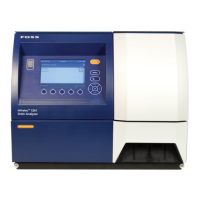Infratec™ 1241 Grain Analyzer
4:2 Service Manual 1001 5015 / Rev. 4
4.1.1 Poor Results
The points listed below can be considered as a check list for trouble shooting “poor”
results. The reasons for “poor” results can be divided into:
• User problems
• Poor calibrations
• Outliers
• Poor reference data
• Instrument problems (Time for cleaning? see User Manual)
4.1.2 User Problems
• Are they using the right calibration?
• Has there been an adjustment to the slope or intercept in the calibration?
• Are they sure that the moisture basis of the Infratec results is the same as that of
the reference results?
• Do they use adjustment to dry content or constant moisture content?
• How many sub-samples are used?
4.1.3 Poor Calibrations
• Was the calibration developed for this type of sample?
• Was there sufficient data to develop the calibration?
• Was the calibration stabilised for instrument and temperature differences?
4.1.4 Outliers
Results with outliers should always be confirmed by a second analysis.
A sample may be classified as an outlier for a number of reasons:
• The constituent concentration is outside of the calibration range.
• The sample is of a variety for which the NIT spectrum differs greatly from the
samples in the calibration set.
• The product is analysed with wrong AM.
• There is too much foreign material in the sample.
• Movements of the sample during the scan.
• Too high absorbance.
• Packing of sample not good
For each constituent, an outlier will be displayed as a letter (A-E) and a number
(1-5). The letter indicates what kind of outlier it is, as described below, and the
number describes the severity (the higher the number, the stronger the outlier).
A-outlier (residual) and B-outlier (leverage)
An outlier denoted by the letters A and B indicate how closely the NIT spectra of the
sample correlate with the spectra in the calibration set.
C-outlier (sub sample deviation)
An outlier denoted by the letter C indicates that the standard deviation between the
sub predicted values from the individual sub samples is above the set limit.
D-outlier (out of range)
An outlier denoted by the letter D indicates that the low or high limit for the constit-
uent has been exceeded by the predicted value of at least one of the sub samples. This
means that it is possible to get a D-outlier even if the average result on the display is
within the calibration range.

